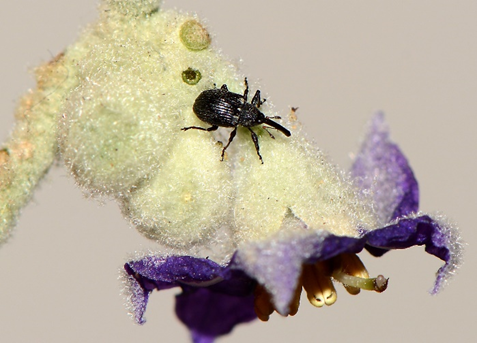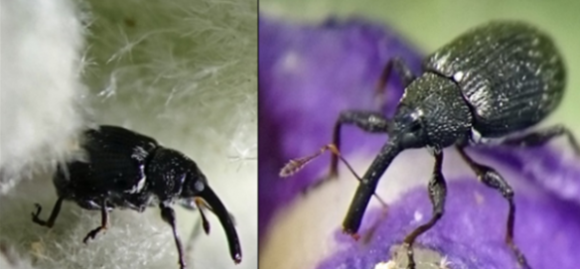14 June 2019 | By Terry Olckers
The flowerbud weevil (Anthonomus santacruzi), which was released in South Africa to reduce fruit production by the invasive bugweed (Solanum mauritianum), is thriving in the coastal regions of KwaZulu-Natal but merely ‘hanging in’ in its inland areas. This was highlighted by surveys of the weevil populations that were conducted by Dr Terry Olckers (University of KwaZulu-Natal) and Ms. Nokwanda Mkhize (C·I·B Honours student) across several bugweed-invaded sites in 2018.

The weevil originates from warm, low-altitude areas in Argentina, where bugweed is native, and is poorly adapted to colder, higher-altitude climates in South Africa. The weevil has consequently become widely established in the coastal areas of KwaZulu-Natal with limited establishment in the province’s higher-altitude, inland areas. Irrespective of location, weevil populations typically display peaks in density during autumn and then decline during winter. The weevil’s pre-winter and post-winter abundance was surveyed at six climatically-optimal coastal sites and six climatically-marginal inland sites to determine how its populations are persisting at sites of variable suitability.
During 2018, pre-winter weevil numbers were six times higher at the optimal sites than at the marginal sites, while post-winter numbers were 22 times higher at the optimal sites. There were substantial population ‘crashes’ during winter at all sites. However, post-winter weevil abundance (i.e. after the ‘crash’) at optimal sites was substantially higher than pre-winter weevil abundance (i.e. before the ‘crash’) at the marginal sites, further emphasizing the climatic constraints experienced by the weevils at marginal sites. Bugweed at marginal sites contained substantially more floral material (i.e. flowers and flower buds) and fruit than bugweed at optimal sites, during both the autumn and spring of 2018. This, coupled with significant negative correlations between weevil numbers and floral/fruit production by bugweed plants, suggests that the weevil is having a negative effect on the weed’s reproductive output. This is important since bugweed plants produce high numbers of fruit that are favoured by fruit-eating birds, which are the
plant’s primary seed-dispersal agents.
“It is clear that the weevil’s populations are barely persisting in climatically-marginal areas,” said Terry Olckers, “implying that additional releases of the weevil in other South African provinces should target locations that are below 300 m in altitude.”
Read the full paper
Mkhize, N.L., Olckers, T. 2019. Persistence of the flowerbud weevil Anthonomus santacruzi in optimal versus marginal areas: implications for the biological control of the invasive tree Solanum mauritianum in South Africa. Biocontrol Science and Technology 29(7): 649-669. https://doi.org/10.1080/09583157.2019.1581133
For more information, contact Terry Olckers at olckerst@ukzn.ac.za

